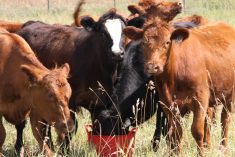SAN ANTONIO, Texas – That prize bull sitting in the pasture chewing its cud may have a short career if it has no interest in cows.
The bull may have passed its semen tests with flying colours, but a low sex drive does not get cows pregnant.
“We know there are differences between bulls, but under the microscope you can’t see the differences,” said reproductive physiologist Rick Funston of the University of Nebraska.
He and other animal scientists talked about cattle reproduction at a seminar held during the recent National Cattlemen’s Beef Association convention in San Antonio.
Read Also

Animal protection delivery to change in Saskatchewan
The Saskatchewan government is looking for a new agency to handle animal welfare after Animal Protection Services of Saskatchewan decided not to renew its contract next year.
George Perry of South Dakota State University said libido is moderately heritable and is not related to scrotal circumference, semen quality and physical conformation.
Libido refers to a bull’s desire to mate, and not all of them are interested.
“Libido has a direct affect on pregnancy rates, and it can influence the success of an entire breeding season,” he said.
“Libido can be practically evaluated by watching a bull after introducing him to a cow herd and determining his desire to detect cows in heat.”
Cows must be detected in standing estrus for successful insemination to occur, which means looking for the changes in animal behaviour associated with a female waiting to be mounted by a bull.
Studies found that 3.6 percent of 166 mature bulls with a satisfactory breeding exam were physically unable to service cows.
They may have had penis deformities or other physical problems or they may not have been interested.
The experts recommend one bull to 40 cows for mature animals with good fertility and libido if the cows are not synchronized.
Yearling bulls should be used at one to 10 cows because they do not have the capacity to breed a lot of cows and they need time to learn.
Cows will all come into heat at once if they have been synchronized with hormone treatments, which puts greater pressure on the bulls. Perry said there is a limit to how many they can service in a day.
Placing multiple sires in a pasture may also lower pregnancy rates because they may do nothing but fight or all breed the same cow.
The greatest benefit of synchronizing cows with natural service is to get more cows pregnant within the first five to seven days of the breeding season.
Perry’s studies have found that during a 65 day breeding season, cows that cycle naturally every 21 days have only three chances to conceive. Cows that are synchronized and show estrus in the first few days of the breeding season have up to four chances to conceive.















